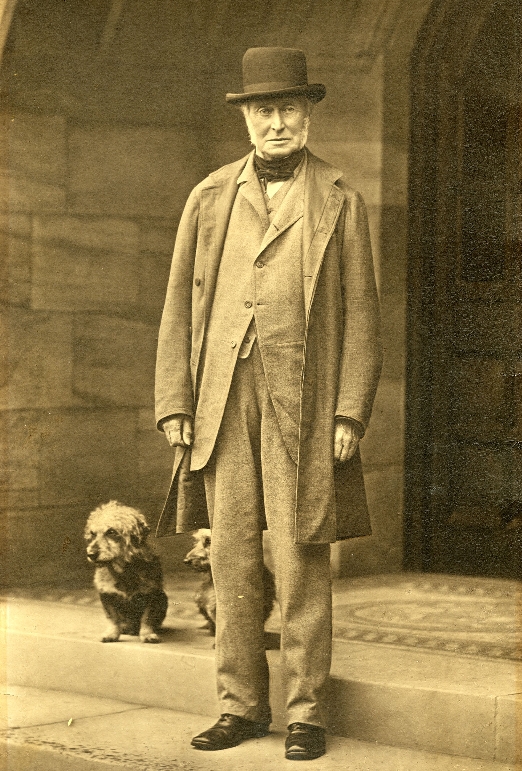
26th November 2010 marks the bicentenary of the birth of Lord Armstrong. William George Armstrong, Baron Armstrong of Cragside, was a scientist, engineer, inventor and businessman. His achievements brought him world renown and fixed Newcastle and the North East of England firmly on the science and engineering map.
This photograph depicts Lord Armstrong standing at the doorway to Cragside, his country home in Rothbury, Northumberland, in c. 1897 when Armstrong was in his old age. In the photograph Armstrong appears to be content, satisfied and self-assured, if a little tired, and a glance at the story of his life and achievements explains why.
Armstrong was born on 26th November 1810 at 9 Pleasant Row, Shieldfield, in Newcastle upon Tyne. He was the only son of William Armstrong, a corn merchant and local politician. Armstrong Senior wanted his son to enter the legal profession and, upon leaving school, Armstrong took articles under the wealthy Newcastle solicitor and family friend Armorer Donkin, becoming a partner in the firm in 1835.
Armstrong was a good solicitor, but his passion lay elsewhere. From an early age he had possessed a fascination with all things scientific and mechanical. This continued into adulthood and a turning point in his life came in 1835 when, during a fishing trip to Dentdale in Yorkshire, his attention was captured by what he recognised as an inefficient use of water in an over-shot water-wheel. Over the next ten years, Armstrong devoted his spare time to developing the effective use of water as a motive power, and his tireless work culminated in his demonstration, to great applause, of a model hydraulic crane at the Literary and Philosophical Institute in Newcastle in December, 1845.
During this early period of his career Armstrong’s imagination was also captured by an aspect of science which was to become one of his greatest loves: electricity. When, in 1840, workers at Cramlington Colliery in Northumberland began to experience electric shocks from steam escaping at high-pressure from a boiler, Armstrong applied his capabilities to establishing and describing the cause of the phenomenon, later named The Armstrong Effect in his honour. He published a series of papers on the effect and developed a spark-inducing hydroelectric machine which he exhibited at the Literary and Philosophical Society. His discovery led to him being elected a fellow of the Royal Society in May 1846.
In the mean time, Armstrong’s hydraulic cranes had impressed many and were in such high demand that, in 1847, he established Messrs W.G. Armstrong & Co., in partnership with Armorer Donkin and others, to manufacture machinery using his hydraulic technology. He finally resigned from his solicitor’s job shortly afterwards. In the same year the partners founded an engineering works at Elswick on the banks of the River Tyne, just to the west of Newcastle. The Elswick Works were to go from strength to strength and evolve through several incarnations over the decades, Armstrong’s reputation as an engineer and a businessman growing alongside them.
In the 1850s Armstrong moved into the field of armament production when he developed a new type of field gun in response to the high loss of life experienced during the Crimean War, and was commissioned to supply the War Office with Armstrong Guns, receiving a knighthood for his services. Later, after the government ended its contract with the Elswick Works, Armstrong went on to sell armaments, including naval guns, indiscriminately to foreign countries. Although this seemed controversial to some, Armstrong felt justified in doing so.
Armstrong became a nationally and internationally renowned figure and, as he amassed great wealth from his engineering successes, he became a great benefactor to his native Newcastle. His gifts included Jesmond Dene, the landscaped park which he gave for the benefit of the town’s inhabitants, and substantial financial support towards the foundation of a College of Physical Science, ultimately to evolve into Newcastle University.
He was awarded many honours for his achievements, including election to the Presidency of the British Association for the Advancement of Science in 1863. During his inaugural address as President at the Association’s meeting in Newcastle in the same year, he spoke about the issue of finite coal reserves and the potential for harnessing solar power, adding “visionary” to his many other accolades.
In the same year, Armstrong purchased land near Rothbury and began the construction of his country residence Cragside, where he would increasingly spend his time as he retired from the day-to-day running of the business. These later years of Armstrong’s life saw his love-affair with electricity re-surface when, in keeping with his instinct for innovation, Cragside was the first house in the world to be lit using hydroelectric power and the first to be lit by Joseph Swan’s newly-invented incandescent light. He experimented further with electricity and in 1897 published the volume Electric Movement in Air and Water which contained a set of striking photographic images of electric discharges taken by the Rothbury-based photographer John Worsnop, who also took the photograph of Armstrong shown here.
Armstrong was raised to the peerage as Baron Armstrong of Cragside in June 1887. When he died in 1900, he left an enduring legacy and was remembered as having been a towering figure of the Victorian era.
